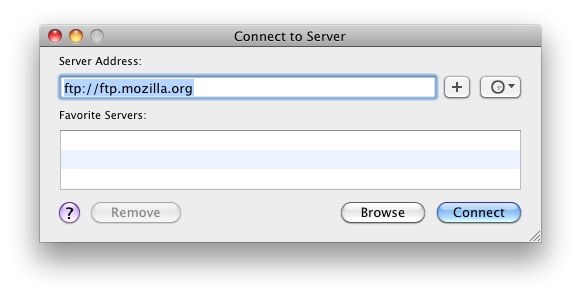Ftp For Mac Terminal

For basic ftp syntax see the main ftp page
This page lists Advanced Options, Cancelling FTP, File Naming Conventions, .netrc file, Command Line Editing, Command Line Prompt and Environment.
FTP from the Mac Terminal – how do you fix the “Is a directory” error? We were playing around with the Terminal on the Mac to FTP some things over to an FTP site. After we had FTP’d to our site, we had tried running this command. File manager & FTP client for Mac Commander One is a versatile file manager for Mac. The number of essential features and handy options makes the application a great alternative to the default file management solutions – be it a Finder or Total Commander. Commander One 2 is here! MacOS does not come with an FTP command line tool. You can connect read-only (just for downloading things) to FTP servers using Finder. Open Finder and choose Go → Connect to Server (⌘K or ) and enter ftp://ftp.gnu.org/. When prompted for a username and password, choose Guest if the server does not require authentication, which is the case with ftp.gnu.org.

The client host with which ftp is to communicate can be specified on the command line. If this is done, ftp will immediately attempt to establish a connection to an FTP server on that host; otherwise, ftp will enter its command interpreter and await instructions from the user. When ftp is awaiting commands from the user the prompt `ftp>' is provided to the user.
To cancel a file transfer, use the terminal interrupt key (usually Ctrl- C). Sending transfers will be immediately halted. Receiving transfers
will be halted by sending an FTP protocol ABOR command to the remote server, and discarding any further data received. The speed at which
this is accomplished depends upon the remote server's support for ABOR processing. If the remote server does not support the ABOR command, the prompt will not appear until the remote server has completed sending the requested file.
If the terminal interrupt key sequence is used whilst ftp is awaiting a reply from the remote server for the ABOR processing, then the connection will be closed. This is different from the traditional behaviour (which ignores the terminal interrupt during this phase), but is considered more useful.
Files specified as arguments to ftp commands are processed according to the following rules.
1. If the file name `-' is specified, the stdin (for reading) or stdout (for writing) is used.
2. If the first character of the file name is `|', the remainder of the argument is interpreted as a shell command. ftp then forks a shell, using popen(3) with the argument supplied, and reads (writes) from the stdout (stdin). If the shell command includes spaces, the argument must be quoted; e.g. `'| ls -lt'. A particularly useful example of this mechanism is: `dir ' |more'.
3. Failing the above checks, if `globbing' is enabled, local file names are expanded according to the rules used in the csh(1); c.f. the glob command. If the ftp command expects a single local file (e.g. put), only the first filename generated by the 'globbing' operation is used.
4. For mget commands and get commands with unspecified local file names, the local filename is the remote filename, which can be altered by a case, ntrans, or nmap setting. The resulting filename can then be altered if runique is on.
5. For mput commands and put commands with unspecified remote file names, the remote filename is the local filename, which can be altered by a ntrans or nmap setting. The resulting filename can then be altered by the remote server if sunique is on.
COMMAND LINE EDITING
ftp supports interactive command line editing, via the editline(3) library. It is enabled with the edit command, and is enabled by default if input is from a tty. Previous lines can be recalled and edited with the arrow keys, and other GNU Emacs-style editing keys can be used as well.
The editline(3) library is configured with a .editrc file - refer to editrc(5) for more information.
An extra key binding is available to ftp to provide context sensitive command and filename completion (including remote file completion). To use this, bind a key to the editline(3) command ftp-complete. By default, this is bound to the TAB key.
Correct execution of many commands depends upon proper behavior by the remote server.
An error in the treatment of carriage returns in the 4.2BSD ascii-mode transfer code has been corrected. This correction can result in incorrect transfers of binary files to and from 4.2BSD servers using the ascii type. Avoid this problem by using the binary image type.
ftp assumes that all IPv4 mapped addresses (IPv6 addresses with a form like ::ffff:10.1.1.1) indicate IPv4 destinations which can be handled by AF_INET sockets. However, in certain IPv6 network configurations, this assumption is not true. In such an environment, IPv4 mapped addresses must be passed to AF_INET6 sockets directly. For example, if your site uses a SIIT translator for IPv6-to-IPv4 translation, ftp is unable to support your configuration.
'Happy is harder than money. Anyone who thinks money will make them happy, doesn't have money ~ David Geffen
Ftp For Mac Terminal Linux
Related macOS commands:
For basic ftp syntax see the main ftp page
getservbyname(3), editrc(5), services(5), ftpd(8)

Ftp Terminal Mac Os
Some rights reserved
